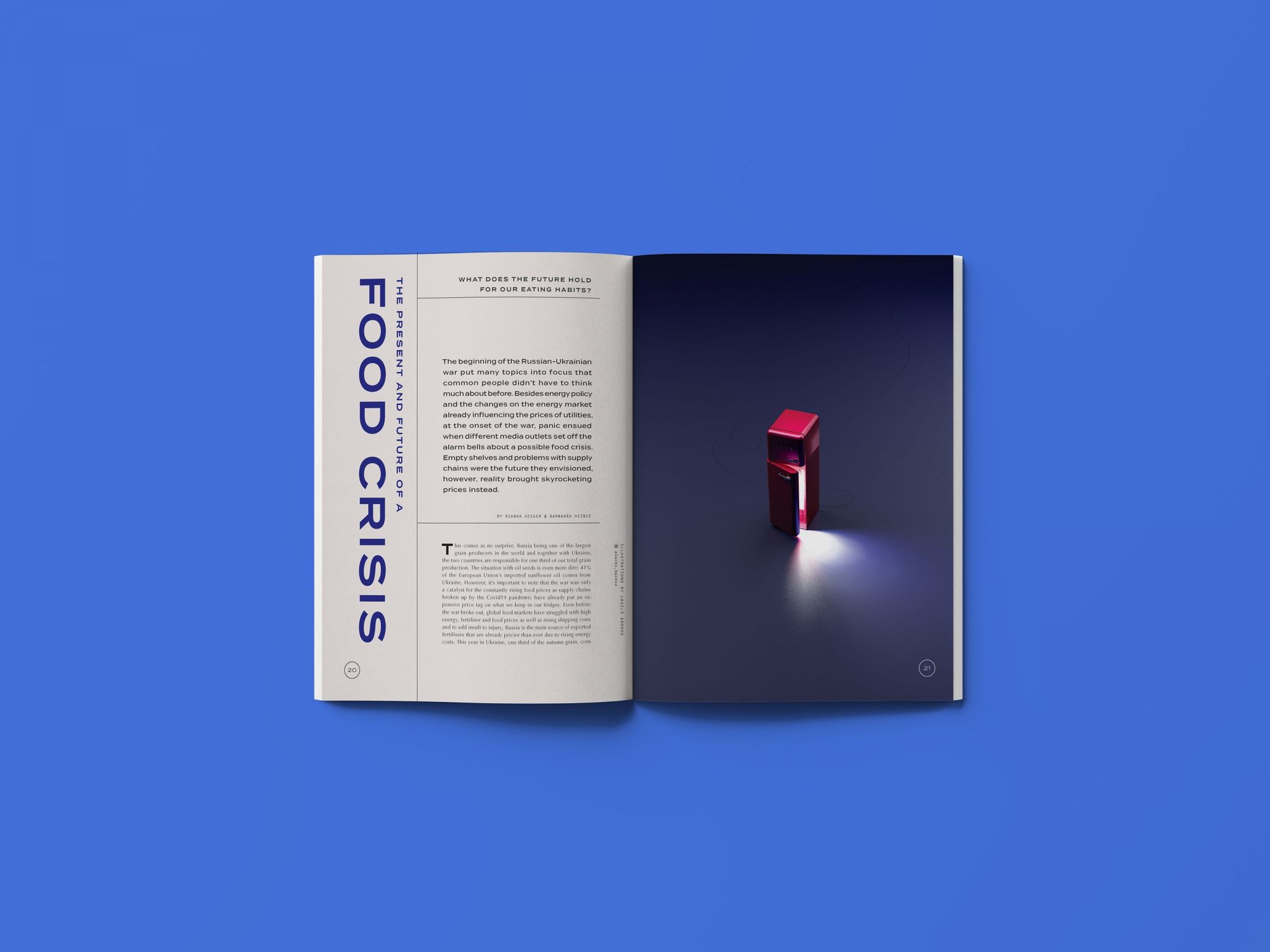The beginning of the Russian-Ukrainian war put many topics into focus that common people didn’t have to think much about before. Besides energy policy and the changes on the energy market already influencing the prices of utilities, at the onset of the war, panic ensued when different media outlets set off the alarm bells about a possible food crisis. Empty shelves and problems with supply chains were the future they envisioned, however, reality brought skyrocketing prices instead.
This article was published in print in Hype&Hyper 2022/2.
Written by Bianka Geiger & Barnabás Heincz
Illustration by László Bárdos
This comes as no surprise, Russia being one of the largest grain producers in the world and together with Ukraine, the two countries are responsible for one third of our total grain production. The situation with oil seeds is even more dire: 41% of the European Union’s imported sunflower oil comes from Ukraine. However, it’s important to note that the war was only a catalyst for the constantly rising food prices as supply chains broken up by the Covid19 pandemic have already put an expensive price tag on what we keep in our fridges. Even before the war broke out, global food markets have struggled with high energy, fertiliser and food prices as well as rising shipping costs and to add insult to injury, Russia is the main source of exported fertilisers that are already pricier than ever due to rising energy costs. This year in Ukraine, one third of the autumn grain, corn and sunflower seed fields are not utilised or left unharvested. Due to the situation created by the war, Ukraine suspended merchant shipping in its ports on the Black Sea, while Russia’s trade in grains is increasingly affected by Western sanctions. All these factors add up to a very dangerous situation on the global food market. As India did on the export of grains, aligning with the changing international environment, a growing number of states announced export-restricting measures, enhancing the atmosphere of global uncertainty and constantly contributing to rising food prices.

In March, all the above culminated in the food price index of the Food and Agriculture Organization of the United Nations (FAO) to hit a historical high. The price index of grains is closing in on its peaks of 2008 and 2011, while the price index of vegetable oils skyrocketed as we’ve never seen before. In one year, the price of wheat got 60% more expensive, only 10-20% of which is due to the direct influence of the war. The price of corn has grown 40% in one year, while, according to FAO, the war in Ukraine is projected to drive the price of oil seeds up by 10.5-17.9%. The scarcity of wheat and corn used as animal feed increases the price of fodder and therefore influences the cost of animal production, especially in the feed-heavy poultry and pig sectors, driving up the price of their meat.
All of this paints a rather dark picture looking at which it’s safe to say that we are in for a serious food crisis that will stay with us in the long run. However, the situation improved a little compared to the shock in March, as FAO’s price index decreased by 0.8% in April compared to the record high of March 2022. Even though still not ideal, this tendency shows signs of improvement that might alter our food market forever. We asked agricultural market analyst and founder of Agrina Consulting, Gábor Nagy about what we are going to have in our fridges in the future.
“To put it simply: we are going to have what we can afford and what we want to buy in our fridges. Unlike most politicians, I wouldn’t say we’re going to face food shortages in the EU. The EU has one of the most developed markets in the world characterised by well-off consumers, stable legal systems and functional commercial relationships. This means that if a product is readily available and meets the EU’s food safety standards, you’ll be able to find it on the shelves of supermarkets. The price of the products is an entirely different question, however. It all depends on the purchase price that defines the price the consumers would have to pay. Let me give you an example: even though sunflower oil is the product most influenced by the war in Ukraine, the EU Vegetable Oil and Proteinmeal Industry Association (FEDIOL) announced on May 4th, that there’s no shortage of sunflower oil. And the same goes for other food products as well.
What directly affects the consumer is the price of products. It’s worth exploring what factors determine the price we have to pay for our food. First in line is the product’s purchase price. Grocery store chains possess great lobbying power, this is a well-known fact. However, even they don’t have the option to debate the rising costs of production. In this regard, the skyrocketing price of fertilisers is the most crucial factor with the price of fuel getting out of hand coming in close second. The former is also likely to have a lasting effect as the EU restricts the agents currently used in pest management, resulting in the new active ingredients hitting the market with new patents, further driving up prices. Producers report that compared to their previous experiences in the current climate filled with political messages, they can enforce their higher prices on processors and those utilising their feed more easily. The difference in exchange rates of local currencies and the Euro also plays an important role in the CEE region. Based on the experiences of 2008, countries outside of the eurozone are hit harder by economic crises. Every piece of negative news influences the exchange rates, resulting in higher prices of imported goods. State interferences also plays a key part in prices. Price fixing might sound good in national communication, but in reality, the loss generated by maximisation is spread between the food items not included in the measures as private market investors can’t be forced to realise loss in the long run.
People are always going to spend money on food. The question we need to answer in the coming months is what products Central European consumers are willing to give up without them feeling a considerable change in their lifestyles compared to how they lived before. I have a strong feeling that the food industry is not going to be the underdog in this competition. Our fridges are not going to be empty, however, their contents might change.”
Another important aspect is how food producers alter the recipes to optimise their costs. Due to rising sunflower oil prices, new recipes are utilised, and producers are looking for alternative solutions to decrease the cost of ingredients used. This means that the contents of our fridges might change even without us knowing. What does the war in Ukraine have to do with the ingredients in our food and the amount of packaging used? We asked food policy analyst Réka Szöllősi about the phenomenon.
“Since the beginning of the war, we get to know our neighbouring giant, Ukraine, a lot better. The fact that the country that is six times larger than Hungary is one of the breadbaskets of the world, might have surprised many people. This means that in the case of several agricultural raw materials—including wheat and sunflower—Ukraine plays a key role in creating food safety and providing commodities for food producers for many different countries. This is exactly the reason why food processing establishments in Europe got into trouble. Not only because of the skyrocketing energy prices induced by the war, but also due to the very real threat that the ingredients they use to produce food—such as sunflower oil—will simply disappear from the market without supplies coming from Ukraine, not to mention the sudden and considerable rise in prices prompted by the decrease in the amounts of ingredient and supplementary ingredient resources. Producers, therefore, are forced to look for alternative recipes and thus change the list of ingredients used on their products’ packaging.
Needless to say, neither of these are easy—substituting sunflower oil with other oils or fats might noticeably alter the flavour, texture and best by date of the product. The problem with being forced to change the packaging is that due to high prices of packaging materials, companies order supplies in large quantities that would be very costly and worrisome from an environmental point of view to be forced to discard. Taking all these factors into account, several European countries passed transitional rules to prevent unnecessary waste and provide the flexibility needed for companies to survive this hopefully transitional phase. On the other hand, providing information and safety to consumers can never take the back seat, that’s why transitional measures ensure that we can make decisions about our food choices with the necessary information at our fingertips, meaning that as consumers, there is no way we won’t be aware if sunflower oil is substituted in a product with soy oil that has the potential to cause allergic reactions for some. To summarise, the war in Ukraine influences our everyday lives in many ways and therefore the current situation requires patience, caution and flexibility on the side of food producers, authorities and the consumers as well.”
People are really good at adapting to new circumstances—when an ingredient disappears from the market or its source runs out, in a few years, gastronomy quickly changes according to the new situation. For example, during the Turkish occupation of Hungary, the closure of Eastern trade routes cut us off from exotic spices, therefore, Hungarians started using a lot of paprika and black pepper instead. Or during the World Wars when meat was hard to acquire, different protein and fat-rich meat substitutes appeared on the market and people cooked with what they had readily available—mostly potatoes and corn.
Nowadays we need to face many challenges prompted by the scarcity of ingredients caused by the war, inflation and different food allergies. Experts are always on the lookout for alternative food options for the far and not-so-far future, and these substitutes are usually ingredients never used before or neglected that could provide a solution on a global scale. Plant-based diets gaining momentum is evident not only for being fashionable but due to important benefits to human health and the environment as well. Légumes are claimed to take the spotlight in the coming years for being rich in protein and fibre. Pea protein is already the basis of most vegan protein powders for having a neutral taste and being hypoallergenic. The company Huel, for example, is experimenting with everything-free instant comfort meals that are able to provide for a person’s daily nutritional needs. Entomophagy—the technical term for consuming insects—is a controversial, yet highly important topic. It’s also not as alien from humans as one would think: in several African and Asian cultures, eating insects has been a tradition for centuries.

We talked to José Guerrero, who graduated from Basque Culinary Center, then went on to learn the ropes in the best restaurants of Europe and worked as an R&D chef in Hungarian restaurants Arany Kaviár and UMO, recently launched the innovative ANIMA project with the goal of designing sustainable, environmentally-friendly and enjoyable dishes with the toolkit of research & development and design. He is a devout believer in collaboration and develops plant-based protein products with Thimus as well as experimenting with new flavours with the help of fermentation and microbiology. Exploring the opportunities of how different senses play a part in consuming food or food-based 3D printing are the other fields he finds exciting.
How do you think the new situation the war has created will impact people’s diets?
A war in a country is a situation that has a direct impact on our food system and on people’s diets. Ukraine produces around 70 million tons of different grains and légumes. When a country with such high levels of production is affected by war the first things impacted are supply chains, making the availability of products low, prices skyrocketing, and restrictions appearing. When this happens, people are made to look for substitutes for the disappearing ingredients and that might affect their daily diet either in a good or a bad way.
Migration also has a clear impact. According to the UN*, more than 5.7 million Ukrainians have already left their country for the following nations: Poland welcomed 3,143,550 refugees, Romania 856,941, Russia 727,712, while for Hungary the number is 551,010. This many refugees directly affects the diet of the areas of concentration. In this case, it’s not about the number of people arriving, but the migration of culture, traditions and beliefs that are directly affecting the hosting country’s diet. There’s going to be a cultural exchange that will slowly have an impact on the next generations, by mixing food cultures.
Is looking for substitute ingredients the way to go or should we be more open to trying new flavours and textures?
The lack of ingredients presents a big challenge for both the food industry and the consumer. Speaking from the food industry’s point of view, for us at ANIMA research, the biggest challenge is to develop new and innovative solutions and our approach is to have a positive impact by designing new products, such as coming up with new flour bases and oils that are more sustainable for the environment and healthier for the consumer. As consumers, we are living in an illusion created by the industry where ingredients are available even when they are not, so I think that experimenting with new flavours and looking for substitutes falls more on the industry than the consumer.
Right now, what ingredients seem to have the most potential?
Thanks to the scientific approach of the food industry, the number of substitutes for everyday diet items is huge. Insects are very controversial in most European countries, however, in Latin America and Asia, they have been a common ingredient for flours and oils and an important source of protein. At ANIMA, we research microgreens to see if flour can be sourced from them, and there are also a lot of labs experimenting with cultured or fermented foods.
Is a plant-based diet our future?
It’s difficult to imagine a future without animal meat. Humans have been consuming meat since the beginning and it’s a habit that is really hard to change. The consumption of meat has been proven to be purely hedonic as our bodies don’t require animal protein to survive. However, the future is not that dire. Nowadays, there are a lot of great projects in the field of the plant-based food industry, for example, at ANIMA project, we are developing a line of research focusing on plant-based proteins in which our goal is to design a methodology that allows consumers to reduce their animal protein consumption. We are partnering with neuroscientists since our approach is to design food by humans for humans, and in order for us to do that, we need to understand how the human brain works.
Nourishment vs. enjoyment – what is more important? Would we be able to give up food and just consume pills if we knew it was enough for us to stay healthy?
In a pragmatic sense, nourishment is always the most important factor, however, it’s clear that enjoyment is of key importance. Our food choices are heavily influenced by how much enjoyment the product brings. Our present decisions are going to force us in the future to fill our bodies with pills if we don’t change the way we eat and live now. Humanity is over-depleting its available resources, and industries are promoting unhealthy practices that are followed by millions of people all over the world. This is creating the philosophy of “the faster, the better” and is going to force us to enjoy the pills we are going to be left with as a source of nutrients.
Is there a way for us to be more conscious of our everyday food choices? Are there any techniques (e.g. fermentation) that are worth exploring?
The best way to start a change in mentality is always through education. It doesn’t require a huge effort to read labels, to understand where our ingredients are coming from, to choose the products of local producers, and to generally be more conscious about the way we eat. There are a lot of very interesting and “trendy” techniques like fermentation, but this means nothing if the kombuchas on the market are full of sugar. Fermentation can have a damaging effect if people don’t educate themselves before venturing into it. Fermentation should be done responsibly for it to become a positive tool for change. The basis of a conscious kitchen lies in our daily choices—when you know where your food is coming from, and you can control it, that’s when your life will start to change for the better.

Prefer to read it in print? Order the fourth issue of Hype&Hyper magazine from our online Store!

Knowledge sharing and Lake Balaton: the first TEDxBalaton begins











